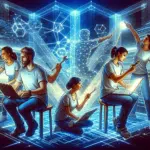Virtual reality (VR) creates an immersive computer-generated simulation or environment that allows users to interact with a three-dimensional (3D) world. The experience is usually created by using specialized software and hardware, such as a VR headset or glasses, which allows users to see the simulated environment in stereoscopic 3D.
VR technology is designed to create a sense of presence, transporting users into a different reality where they can interact with digital objects and environments in real time. Users can move around, manipulate objects, and even communicate with other users in the virtual environment.
The applications of VR technology are vast and varied. In the entertainment industry, VR can be used to create immersive gaming experiences and virtual theme parks. VR can help generate training simulations, such as surgeries or emergency procedures in the medical industry. VR can also create interactive learning experiences that allow students to explore different environments, such as historical sites or scientific concepts in the education industry.
VR technology is still in its early stages, and the potential applications of this technology are vast. As the technology continues to improve, we will likely see even more innovative uses for VR, from virtual meetings and conferences to remote workspaces and training simulations.





